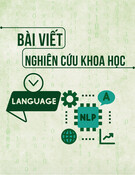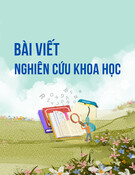
TNU Journal of Science and Technology
229(03): 27 - 33
http://jst.tnu.edu.vn 27 Email: jst@tnu.edu.vn
DIFFICULTIES IN ENGLISH-VIETNAMESE TRANSLATION
FACED BY ENGLISH-MAJORED STUDENTS AT
THAI NGUYEN UNIVERSITY OF TECHNOLOGY
Tran Manh Hoang*, Luong Van Hieu
TNU - University of Technology
ARTICLE INFO
ABSTRACT
Received:
10/6/2023
This paper presents a study into difficulties in English – Vietnamese
translation faced by English-majored students. Although basic knowledge
of English with four main skills is delivered to the students at the
beginning of their academic courses at university, translation in general
causes tons of troubles for them. Therefore, this research was conducted
to figure out what makes translating, especially English-Vietnamese
written translation, rather difficult for English majors in their acquisition
of knowledge. Besides that, this paper also aims to suggest some feasible
ways – an initial step towards enhancing students’ translation quality. The
research was conducted with a survey and the data were analyzed
quantitatively. A questionnaire of 10 questions and a list of 20 English
words for translation practice were employed to find out the student’s
attitudes and strategies to translate specialized English. The results show
that most of the surveyed students found it hard to translate from
specialized English into Vietnamese. This is because specialized English
is quite different from everyday English and the students are only familiar
with the basic meanings of their vocabulary. This paper is a practical
reference for students and it can help teachers better understand their
students’ weaknesses and difficulties in translation.
Revised:
31/7/2023
Published:
31/7/2023
KEYWORDS
Written translation
English-majors
Equivalence
Attitude
Difficulty
KHÓ KHĂN TRONG BIÊN DỊCH ANH - VIỆT CỦA SINH VIÊN NGÀNH
NGÔN NGỮ ANH TẠI TRƯỜNG ĐẠI HỌC KỸ THUẬT CÔNG NGHIỆP
Trần Mạnh Hoàng*, Lường Văn Hiếu
Trường Đại học Kỹ thuật Công nghiệp – ĐH Thái Nguyên
THÔNG TIN BÀI BÁO
TÓM TẮT
Ngày nhận bài:
10/6/2023
Bài báo này trình bày nghiên cứu về khó khăn của sinh viên Ngôn ngữ
Anh trong dịch thuật Anh – Việt. Mặc dù sinh viên được cung cấp kiến
thức cơ bản về tiếng Anh với 4 kỹ năng chính ngay khi theo học chuyên
ngành tại trường đại học, việc dịch thuật vẫn luôn gây ra vô số phiền phức
cho các em. Do đó, nghiên cứu này được thực hiện nhằm tìm ra nguyên
nhân khiến việc dịch thuật, đặc biệt là dịch viết Anh - Việt, trở nên khó
khăn đối với sinh viên ngôn ngữ Anh. Bên cạnh đó, nghiên cứu này cũng
nhằm đề xuất một số giải pháp khả thi – bước đầu nâng cao chất lượng
dịch thuật của sinh viên. Nghiên cứu được thực hiện bằng khảo sát và
phân tích định lượng. Một bảng khảo sát với 10 câu hỏi và một danh sách
20 từ tiếng Anh chuyên ngành được sử dụng để tìm hiểu thái độ cũng như
chiến lược của sinh viên đối với dịch thuật chuyên ngành. Kết quả cho
thấy hầu hết sinh viên gặp khó khăn trong dịch thuật Anh – Việt chuyên
ngành. Lý do là bởi tiếng Anh chuyên ngành rất khác biệt với tiếng Anh
giao tiếp. Nghiên cứu này là một tham khảo thực tế cho sinh viên cũng
như giúp giáo viên hiểu rõ hơn về những điểm yếu cũng như khó khăn của
sinh viên trong dịch thuật Anh-Việt.
Ngày hoàn thiện:
31/7/2023
Ngày đăng:
31/7/2023
TỪ KHÓA
Dịch viết
Chuyên ngành Ngôn ngữ Anh
Cách diễn đạt tương đương
Thái độ
Khó khăn
DOI: https://doi.org/10.34238/tnu-jst.8102
* Corresponding author. Email: tranmanhhoang@tnut.edu.vn

TNU Journal of Science and Technology
229(03): 27 - 33
http://jst.tnu.edu.vn 28 Email: jst@tnu.edu.vn
1. Introduction
“The study of translation and the training of professional translators is without question an
integral part of the explosion of both intercultural relations and the transmission of scientific and
technological knowledge” [1]. Newmark once wrote: “The first traces of translation date from
3000 BC, during the Egyptian Old Kingdom, in the area of the First Cataract, Elephantine, where
inscriptions in two languages have been found” [2]. Over millennia, it is not only an instrument
for exchanging one’s thoughts, ideas, concepts, etc. with another, but it has also been a
professional occupation that lucratively benefits a translator or an interpreter a lot. Moreover,
“There must always have been interpreters for people, in spite of their differences, their rivalries
and perhaps because of these, they have always experienced the need to communicate and there
have always been many languages” [3]. Translation may be defined as “the replacement of
textual material in one language (source language) by equivalent textual material in another
language” [4]. Equivalence means equal value. Sometimes the value is on the level of form (two
words translated by two words); sometimes it is reference (Friday is always the day before
Saturday); sometimes it is function (the function “bad luck on 13” corresponds to Friday in
English, to Tuesday in Spanish) [5]. According to Tytler, a perfect translation should be an exact
copy of original ideas, feelings, and style [6]. In Skopos theory, “to translate means to develop a
target text in a target setting or a target purpose in target situations” [7]. This theory assumes that a
translation always has an aim, which is the decisive factor influencing the translator’s decisions
[8]. In order to produce a high-quality translated text, a translator is required much more than
proficiency in multiple linguistics. Cultural factors are often classified as non-linguistic knowledge
(equivalence above word level) which can cause a lot of difficulties for translators [9].
Translators may be called upon to translate about anything. The most widely-known
subcategories of translation are those of materials with specialized subject matter: technical
translation, commercial translation, financial translation, information technology translation… [10].
Fortunately, English-majored students at Thai Nguyen University of Technology (TNUT) get the
chance to study almost all of these materials. However, when it comes to specialized translation, it is
obvious that they might experience considerable difficulties. The first common difficulty is that
translators do not master both the source language and the target language [11]. The second but more
serious difficulty is that it is impossible to gain deep knowledge in every specialized field. With so
many gaps in vocabulary, students will not only fail to achieve high results in practical subjects, but
will also face many difficulties when studying specialized subjects [12]. People might encounter
specialized materials everywhere, especially in printed newspapers, magazines or online press. For
example, advertising translation has become increasingly important for today’s globalization of
products and service [13]. In order to translate these contents, translators must have general
knowledge of journalism, especially the characteristics of language in printed or online media [14].
Throughout the four academic years of pursuing the Bachelor’s degree in the English Language, the
researchers assumed that every student may get into trouble reproducing an English text into
Vietnamese. Understanding the significance of finding out difficulties and possible solutions is the
motivation to the researchers for conducting this study with the hope that it will be a valuable
reference to English-majored students at Thai Nguyen University of Technology. Hence, they will
be able to enhance the quality of their translation projects in the university and in their career.
2. Methodology
2.1. The subjects
The participants were K55, K56, and K57 students who were doing Bachelor’s degree in the
English language at Thai Nguyen University of Technology. They partly consisted of K55
students who had attended the written translation subject for a period of time. The rest were K56
and K57 students who were about to officially study this subject in the following years. However,

TNU Journal of Science and Technology
229(03): 27 - 33
http://jst.tnu.edu.vn 29 Email: jst@tnu.edu.vn
they were all taught the same curriculum which regards a wide variety of topics such as
economics, mechanics, electronics, electrics, etc.
2.2. The instruments
For this study, the questionnaire was thoughtfully designed for students to have the real-life
perspective of studying English-Vietnamese written translation in addition to difficulties in their
learning journey in this field. It was composed of 10 multiple-choice questions, along with 20
English words and phrases. Twenty-three copies were delivered to the English-majored students
ranging from K55 to K57, and twenty-three copies were collected. The multiple-choice questions
were to determine purposes as the following:
The first three questions were for the purpose of identifying students’ attitude towards written
translation subjects in general. The first question was to figure out students’ feelings about
studying written translation and if they find it interesting or not. The second was employed to
pinpoint their response to what they could obtain through the process of learning translation, or
the reasons motivating them to get into this subject. The third one was to recognize whether
English-Vietnamese or Vietnamese-English written translation is more challenging for the
students. The last seven questions were created in a hope that the authors would be capable of
describing what the students tend to take into consideration whenever they have to confront
roadblocks during the rendition process.
In order to make the study more practical and reliable, the English-Vietnamese translation
practice was combined at the end of the questionnaire. Twenty words and phrases were selected
from various topics, i.e., economics, engineering, environment, or even politics, to serve the
purpose of examining the students’ ability to translate those items into Vietnamese.
2.3. Data analysis
IBM SPSS 20.0 statistics software was used to encode, process, and analyze collected data from
the questionnaire. The method of data analysis was the descriptive statistics method. The translation
practice was received and evaluated by the authors who have experience in the topics given in the
third part of the questionnaire. With regard to strategies for translation, the most correct translation
versions were selected to identify the methods used by the students during the translation process.
3. Results and discussion
3.1. The students’ attitude towards learning written translation
More than half of the students (56.52%) responded that studying written translation was
interesting but they did not really take a keen interest in the subject. On the contrary, only 4.35%
of the students found learning the subject exceptionally interesting. This ratio is identical to the
group that considered the written translation subject boring, which may account for the difficulty
of the subject to some extent. That said, the minority of students really struggled to pursue the
written translation field. Whereas, a great number of learners had a neutral perspective (34.78%)
that they might or might not be into studying the subject. It is likely that they thought translation
is kind of exciting but rather difficult to pursue consistently.
Through studying written translation, 34.78% of the students confirmed that they could gain
numerous benefits such as a large amount of vocabulary and grammar, insights into other
cultures, and more. Besides, 39.13% of them only agreed that they could enrich their source of
vocabulary and grammar, and expand more about the different cultures of other nations in the
path of pursuing translation. The number of learners who only partly agreed with the advantages
represents 21.74%; it can be seen that a specific percentage of learners had not yet recognized the
merits of studying written translation, or the merits were not really obvious to them. Still, there
are 4.35% of the students who did not agree with the benefits they could gain by learning the
subject. This is a minor rate, but it reflects that the awareness on the translation subject was not

TNU Journal of Science and Technology
229(03): 27 - 33
http://jst.tnu.edu.vn 30 Email: jst@tnu.edu.vn
very high. Based on the collected results, it can be stated that most of the English-majored
students were generally conscious of the advantages of studying translation. Hence, they
presented a great attitude towards the process of language learning, and they felt motivated to
pursue the subject so that they were able to learn it effectively in their own ways.
3.2. Strategies for translation used by the students to deal with difficulties
Table 1 shows 5 questions which were created in a hope that the authors would be capable of
describing what the students tend to take into consideration whenever they have to confront
roadblocks during the rendition process.
Table 1. The students’ opinion about strategies for dealing with difficulties in translation
Code
Label
Mean
Min.
Max.
Std. Deviation
Q4
When I encounter an English source text, I usually take into
account the meaning of new words, grammatical rules,
expressions, and contexts as well.
2.09
1.00
4.00
0.79
Q5
When I have to deal with new words, I first guess their
meaning from contexts, then look them up in the dictionary
(either online or paper-based).
1.96
1.00
3.00
0.71
Q6
In case I must face a difficult grammatical rule, I often render
it into Vietnamese by what I think it might be.
2.04
1.00
4.00
0.64
Q7
If I encounter non-equivalent elements in the source language,
I will translate them by more specific or general ones,
omission, illustration, or paraphrasing.
2.57
1.00
4.00
1.12
Q8
If I do not understand the characteristics of a culture, I tend to
search for its meaning online via Google. If not, I will consult
experts such as lecturers.
2.17
1.00
5.00
0.94
At first glance, it is apparently noticeable that all the means are around 2.0, but there is a
slight disparity arising from question seven (mean 2.57). In detail, the students are all aware of
considering the whole text with regard to new words, grammatical structures, expression or tone,
and contexts instead of solely translating word to word, or sentence to sentence. That signals a
right approach to take the next step into the field of translation.
Particularly, in terms of understanding the meaning of new words, they all share the idea that
it is necessary to guess the notion of a word through the examination of the context being
presented (mean 1.96). Then, if the meaning cannot be inferred from the context, they will take
advantage of the power of dictionaries to seek the best appropriate meaning. In contrast, they
tend to reproduce a tough grammatical rule just by their knowledge but not by any research on
the connotation of this grammatical point.
With respect to non-equivalents – an element that offers a translator most of the challenges,
the mean is approximately 2.57. It can be seen that the students may perceive strategies for
dealing with non-equivalents, i.e., translation by more specific or general ones, omission,
illustration, or paraphrasing, yet they may not utilize those techniques frequently and effectively.
Finally, the aspect of culture is one of the factors that might be strange to some students;
however, it is indeed surprised at the result shown in the table (mean 2.17). This figure
demonstrates a consensus among the English-majored students that culture plays an intensive
impact in the final translated text. Thus, they are in the view of consulting trustable sources of
information such as trusted websites or lecturers who have profound insights.
3.3. Data analysis from the translation practice
In the final section of the questionnaire, all participants were required to translate a series of
twenty words and phrases from English to Vietnamese, using supportive tools in addition to their
knowledge of the language. The aim of this part was to clarify how precisely the students could be
able to understand and then translate those words and terms. The findings are shown in table 2.

TNU Journal of Science and Technology
229(03): 27 - 33
http://jst.tnu.edu.vn 31 Email: jst@tnu.edu.vn
Table 2. Results of translating English words and terms into Vietnamese
No.
Source texts
Improper
translation
Percentage (%)
(N = 23)
Blank
translation
Percentage (%)
(N = 23)
1
Headline inflation
18
78.3
4
17.4
2
Telecommunication
2
8.7
3
13
3
Expansion
18
78.3
1
4.3
4
Recession
4
17.4
1
4.3
5
Poverty alleviation
1
4.3
1
4.3
6
Macro economics
0
0
1
4.3
7
Policy-makers
6
26.1
3
13
8
Allocate
22
95.7
1
4.3
9
Highlight
0
0
1
4.3
10
Downturn
1
4.3
1
4.3
11
Automation
0
0
1
4.3
12
Blue-chip
5
21.7
11
47.8
13
Conductor
22
95.7
1
4.3
14
Wear
22
95.7
1
4.3
15
Gear
6
26.1
2
8.7
16
Longitude
0
0
4
17.4
17
Equator
0
0
2
8.7
18
Iconic
7
30.4
3
13
19
Biosphere
0
0
3
13
20
Flora
6
26.1
2
8.7
As demonstrated in Table 2, it can be recognized at ease that students are in general able to
render English words and terms into Vietnamese with a specific level of accuracy. This statement
is proven by the percentage of improper translation of 30% and lower, which regards a majority
of words and terms. Nonetheless, there remain five words that account for an extremely high rate
of improper translation: headline inflation (78.3%), expansion (78.3%), allocate (95.7%),
conductor (95.7%), wear (95.7%). The fact is that the training courses in written translation are
concerned with economics, environment, mechanics, technology, and information. Therefore,
those five words and terms should mean in relevant to those topics above.
- Headline inflation is a term used very frequently in economics. Its meaning is “the raw
inflation figure reported through the Consumer Price Index (CPI) that is released monthly by the
Bureau of Labor Statistics (BLS)” [15]. In Vietnamese, it is so-called “lạm phát toàn phần”, but
most of the students only responded as “lạm phát”. That said, they ignored the word “headline”
because they do not know the meaning of headline in Vietnamese, or they cannot find it in bilingual
dictionaries (English-Vietnamese). It can be concluded that the students almost completely rely on
dictionaries during the translation process.
- Expansion is extremely familiar to most of the students on regular basis, but if it is concerned
with economics, a high ratio of them wrongly translated it into Vietnamese as these two words:
“bành trướng, khai triển”. Meanwhile, the exact connotation should be “thời kỳ hưng thịnh”, which
refers to, as conceptualized by Daniel Liberto from Investopedia.com, “the phase of the business
cycle where real gross domestic product (GDP) grows for two or more consecutive quarters,
moving from a trough to a peak. Expansion is typically accompanied by a rise in employment,
consumer confidence, and equity markets and is also referred to as an economic recovery” [16].
- Allocate is a word that might be somewhat strange and new to some students as they do not
often touch it. This may contribute to the reality that their translation was incorrect. A majority of
them chose to use the meaning “chỉ định” while it should be translated as “phân bổ”.
- Conductor, in respect of electrical engineering, is a material or object that permits an
electric current to flow easily. Thus, it should carry the meaning “chất dẫn điện” as opposed to
“nhạc trưởng” – the first definition suggested in any dictionary both monolingual and bilingual

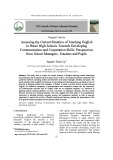



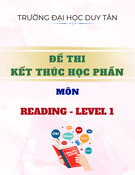
![Đề cương môn Tiếng Anh 1 [Chuẩn Nhất/Mới Nhất]](https://cdn.tailieu.vn/images/document/thumbnail/2025/20251130/cubabep141@gmail.com/135x160/51711764555685.jpg)
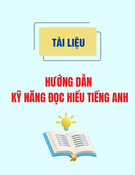

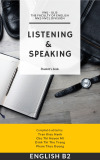
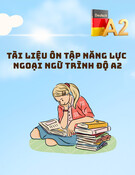
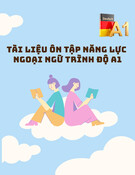
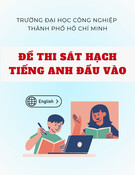
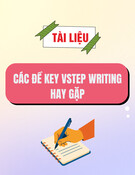
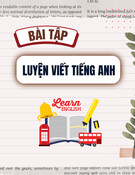
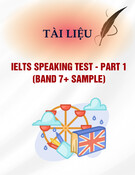

![Mẫu thư Tiếng Anh: Tài liệu [Mô tả chi tiết hơn về loại tài liệu hoặc mục đích sử dụng]](https://cdn.tailieu.vn/images/document/thumbnail/2025/20250814/vinhsannguyenphuc@gmail.com/135x160/71321755225259.jpg)
